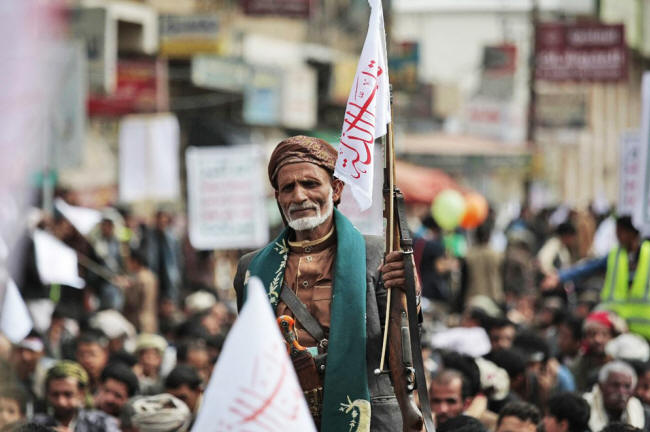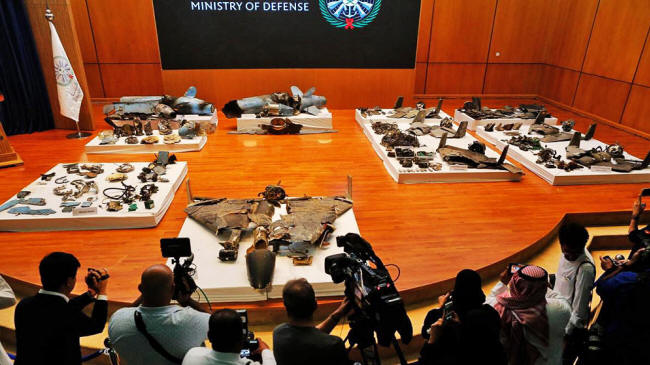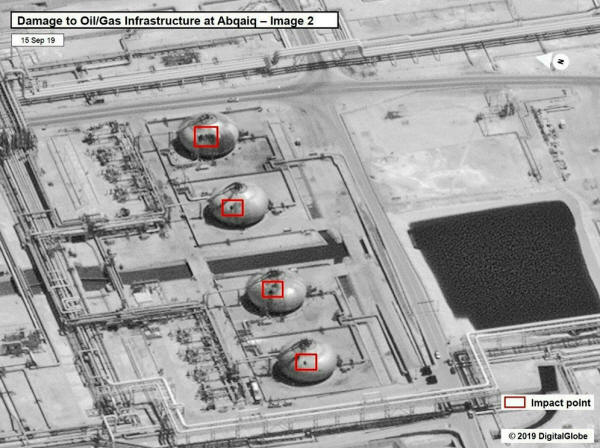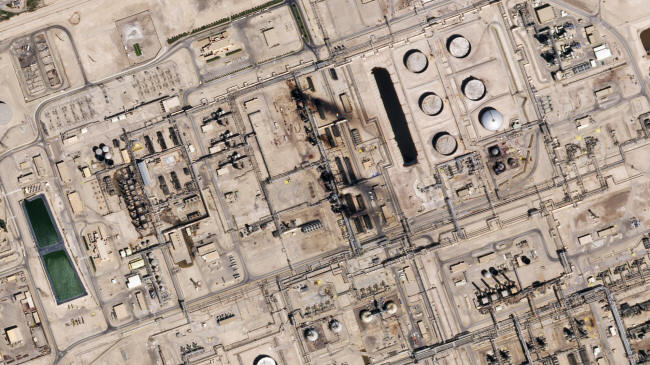|
by Pepe Escobar
A Yemeni Shiite man holds his weapon and a flag with an Arabic inscription reading ‘Disgrace is far from us,' as he takes part in a religious procession held by Houthi rebels to mark the first day of Ashura. Photo: Hani Al-Ansi/dpa
spectacular attack on Abqaiq raises the distinct possibility of a push to drive the House of Saud from power...
We are the Houthis and we're coming to town...
With the spectacular attack on Abqaiq, Yemen's Houthis have overturned the geopolitical chessboard in Southwest Asia - going as far as introducing a whole new dimension:
Blowback is a bitch. Houthis - Zaidi Shiites from northern Yemen - and Wahhabis have been at each other's throats for ages.
This book is absolutely essential to understand the mind-boggling complexity of Houthi tribes; as a bonus, it places the turmoil in southern Arabian lands way beyond a mere Iran-Saudi proxy war.
Still, it's always important to consider that Arab Shiites in the Eastern province - working in Saudi oil installations - have got to be natural allies of the Houthis fighting against Riyadh.
Houthi striking capability - from drone swarms to ballistic missile attacks - has been improving remarkably for the past year or so.
It's not by accident that the UAE saw which way the geopolitical and geoeconomic winds were blowing:
Even before Abqaiq, the Houthis had already engineered quite a few attacks against Saudi oil installations as well as Dubai and Abu Dhabi airports.
In early July, Yemen's Operations Command Center staged an exhibition in full regalia in Sana'a featuring their whole range of ballistic and winged missiles and drones.
The Saudi Ministry of Defense displays drones and parts from missiles used in the refinery attack.
The situation has now reached a point where there's plenty of chatter across the Persian Gulf about a spectacular scenario:
That's not far-fetched anymore.
Stranger things have happened in the Middle East. After all, the Saudis can't even win a bar brawl - that's why they rely on mercenaries.
Orientalism strikes again
The US intel (intelligence service) refrain that the Houthis are incapable of such a sophisticated attack betrays the worst strands of orientalism and white man's burden/superiority complex.
The only missile parts shown by the Saudis so far come from a Yemeni Quds 1 cruise missile. According to Brigadier General Yahya Saree, spokesman for the Sana'a-based Yemeni Armed Forces,
This satellite overview handout image from the US government shows damage to oil/gas infrastructure from weekend drone attacks at Abqaiq.
Houthi armed forces duly claimed responsibility for Abqaiq:
Notice the key concept:
Even more relevant is the fact that massive American hardware deployed in Saudi Arabia inside out and outside in,
...didn't see a thing, or certainly not in time.
The sighting of three "loitering" drones by a Kuwaiti bird hunter arguably heading towards Saudi Arabia is being invoked as "evidence". Cue to the embarrassing picture of a drone swarm - wherever it came from - flying undisturbed for hours over Saudi territory.
UN officials openly admit that now everything that matters is within the 1,500 km range of the Houthis' new UAV-X drone: oil fields in Saudi Arabia, a still-under-construction nuclear power plant in the Emirates and Dubai's mega-airport.
My conversations with sources in Tehran over the past two years have ascertained that the Houthis' new drones and missiles are essentially copies of Iranian designs assembled in Yemen itself with crucial help from Hezbollah engineers.
US intel insists that 17 drones and cruise missiles were launched in combination from southern Iran. In theory, Patriot radar would have picked that up and knocked the drones/missiles from the sky.
So far, absolutely no record of this trajectory has been revealed. Military experts generally agree that the radar on the Patriot missile is good, but its success rate is "disputed" - to say the least. What's important, once again, is that the Houthis do have advanced offensive missiles.
And their pinpoint accuracy at Abqaiq was uncanny.
This satellite overview handout image shows damage to oil/gas infrastructure from weekend drone attacks at Abqaiq in Saudi Arabia. Courtesy of Planet Labs Inc
For now, it appears that the winner of the US/UK-supported House of One Saudi war on the civilian Yemeni population, which started in March 2015 and generated a humanitarian crisis the UN regards as having been of biblical proportions, is certainly not the crown prince, widely known as MBS.
Listen to the general
Crude oil stabilization towers - several of them - at Abqaiq were specifically targeted, along with natural gas storage tanks. Persian Gulf energy sources have been telling me repairs and/or rebuilding could last months.
Even Riyadh admitted as much.
Blindly blaming Iran, with no evidence, does not cut it. Tehran can count on swarms of top strategic thinkers. They do not need or want to blow up Southwest Asia, which is something they could do, by the way:
Professor Mohammad Marandi from the University of Tehran, who has very close relations with the Foreign Ministry, is adamant:
Marandi additionally stresses,
A soft - and unprotected - target:
Readers should pay close attention to this groundbreaking interview (below video) with General Amir Ali Hajizadeh, the commander of the Islamic Revolutionary Guard Corps Aerospace Force.
The interview, in Farsi (with English subtitles), was conducted by US-sanctioned Iranian intellectual Nader Talebzadeh and includes questions forwarded by my US analyst friends Phil Giraldi, Michael Maloof and myself.
Explaining Iranian self-sufficiency in its defense capabilities, Hajizadeh sounds like a very rational actor.
The bottom line:
In response to one of my questions, on what message the Revolutionary Guards want to convey, especially to the US, Hajizadeh does not mince his words:
Get your S-400s or else...
On the energy front, Tehran has been playing a very precise game under pressure:
I have been checking this for weeks with my trusted Persian Gulf traders - and they all confirm it. Iran could go on doing it forever.
Of course, the Trump administration knows it. But the fact is they are looking the other way.
To state it as concisely as possible:
German Chancellor Angela Merkel has warned the administration in so many words:
And now for the really hair-raising part.
The strike at Abqaiq shows that the entire Middle East production of over 18 million barrels of oil a day,
...can be easily knocked out.
There is zero adequate defense against these drones and missiles. Well, there's always Russia...
Here's what happened at the press conference after the Ankara summit this week on Syria, uniting Presidents Putin, Rouhani and Erdogan.
In The Transformation of War, Martin van Creveld actually predicted that the whole industrial-military-security complex would come crumbling down when it was exposed that most of its weapons are useless against fourth-generation asymmetrical opponents.
There's no question the whole Global South is watching - and will have gotten the message.
Hybrid war, reloaded
Now we are entering a whole new dimension in asymmetric hybrid war.
In the - horrendous - event that Washington would decide to attack Iran, egged on by the usual neocon suspects, the Pentagon could never hope to hit and disable all the Iranian and/or Yemeni drones.
The US could expect, for sure, all-out war. And then no ships would sail through the Strait of Hormuz. We all know the consequences of that.
Which brings us to The Big Surprise.
So we're back to the realistic bottom line, which has been stressed by not only Moscow and Beijing but also Paris and Berlin:
Now he must find a face-saving way out... if the War Party allows it...
|





